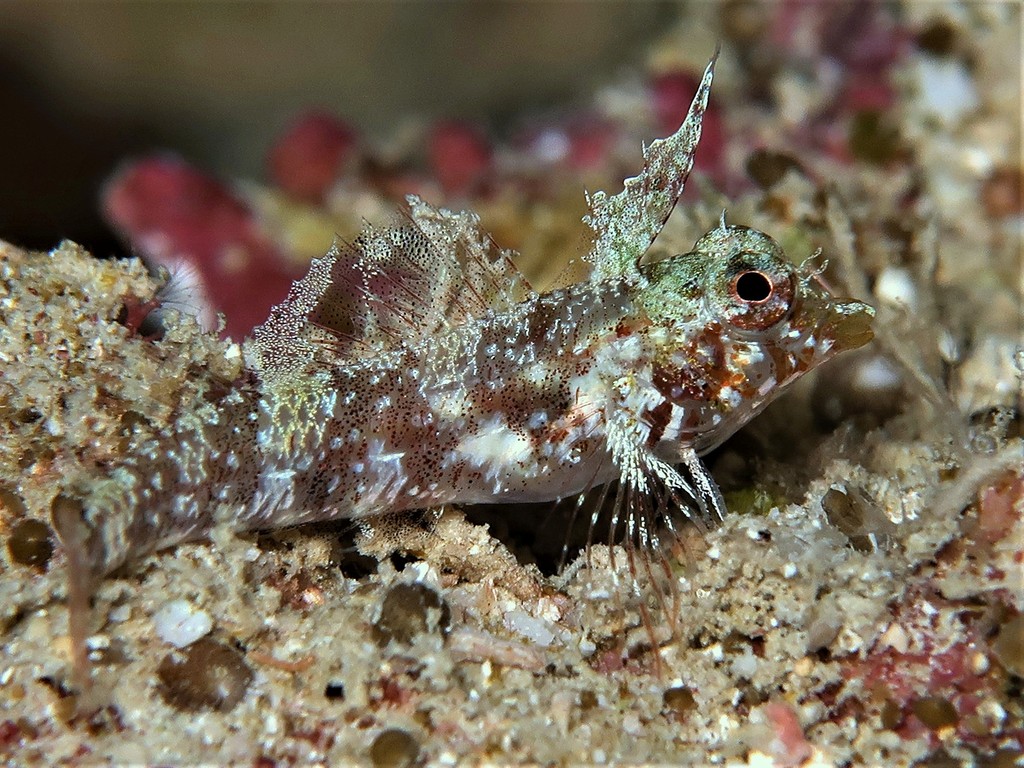ENNEAPTERYGIUS MIRABILIS - (FRICKE, 1994)
Picture courtesy of: Alain Daoulas
Actinopterygii (Gigaclass) > Actinopteri (Class) > Teleostei (Subclass) > Blenniiformes (Order) > Blennioidei (Suborder) > Tripterygiidae (Family) > Tripterygiinae (Subfamily) > Enneapterygius (Genus)
Miracle threefin, Miracle triplefin, Shimahirehebiginpo, シマヒレヘビギンポ, 奇异双线鳚,
Description
First dorsal spines (total): 3; Dorsal spines (total): 10-13; Dorsal soft rays (total): 8-11; Anal spines: 1; Anal soft rays: 16-20; Pectoral fin rays: 13-14; Pelvic fin rays: I,2; Lateral line interrupted: 5-12 + 20-29; Head, chest, and pectoral-fin base scaleless; Short orbital tentacle present; Mandibular pores: 4 + 2 + 4; First dorsal fin very tall, much higher than second dorsal, sometimes with filamentous tip on first spine. Max. length: 3.3 cm TL. Depth range: 8 - 37 m.
Color
Semitransparent greenish with white saddle below near part of second and third dorsal fin, or whitish with 4-5 greenish to brownish bars (sometimes branched ventrally); First dorsal fin and margins of second and third dorsal fin whitish.
Etymology
Enneapterygius: from Greek, ennea = numeral nine + from Greek, pterygion = little fin. Referring to nine fins (3 dorsal, 2 pectoral, 2 ventral or pelvic, 1 anal, 1 caudal).
mirabilis: from Latin, mīror, mīrus = to marvel at, wonderful + from Latin suffix, -bilis =-able. Referring to its “unusually large first dorsal and pectoral fins, which look very pretty”.
Original description: Enneapterygius mirabilis Fricke, 1994 - Type locality: Escape Reef, 15°49'S, 145°50'E, Cooktown area, Queensland, Australia, depth 10-14 meters.
Distribution
Western Pacific: West Papua (Indonesia) and Papua New Guinea east to Vanuatu, south to Queensland (Australia) and New Caledonia.
Biology
Adults are found in coral reef areas, on reef slopes close to the outer reef. Eggs are hemispherical and covered with numerous sticky threads that anchor them in the algae on the nesting sites. Larvae are planktonic which occur primarily in shallow, nearshore waters.
Similar species
Enneapterygius altipinnis (Clark, 1980) - Reported from Red Sea, western Indian Ocean: East Africa to Seychelles, Comoros and Madagascar.
Enneapterygius tutuilae (Jordan & Seale, 1906) - Reported from New Caledonia - Link to the species (here).
Actinopterygii (Gigaclass) > Actinopteri (Class) > Teleostei (Subclass) > Blenniiformes (Order) > Blennioidei (Suborder) > Tripterygiidae (Family) > Tripterygiinae (Subfamily) > Enneapterygius (Genus)
Miracle threefin, Miracle triplefin, Shimahirehebiginpo, シマヒレヘビギンポ, 奇异双线鳚,
Description
First dorsal spines (total): 3; Dorsal spines (total): 10-13; Dorsal soft rays (total): 8-11; Anal spines: 1; Anal soft rays: 16-20; Pectoral fin rays: 13-14; Pelvic fin rays: I,2; Lateral line interrupted: 5-12 + 20-29; Head, chest, and pectoral-fin base scaleless; Short orbital tentacle present; Mandibular pores: 4 + 2 + 4; First dorsal fin very tall, much higher than second dorsal, sometimes with filamentous tip on first spine. Max. length: 3.3 cm TL. Depth range: 8 - 37 m.
Color
Semitransparent greenish with white saddle below near part of second and third dorsal fin, or whitish with 4-5 greenish to brownish bars (sometimes branched ventrally); First dorsal fin and margins of second and third dorsal fin whitish.
Etymology
Enneapterygius: from Greek, ennea = numeral nine + from Greek, pterygion = little fin. Referring to nine fins (3 dorsal, 2 pectoral, 2 ventral or pelvic, 1 anal, 1 caudal).
mirabilis: from Latin, mīror, mīrus = to marvel at, wonderful + from Latin suffix, -bilis =-able. Referring to its “unusually large first dorsal and pectoral fins, which look very pretty”.
Original description: Enneapterygius mirabilis Fricke, 1994 - Type locality: Escape Reef, 15°49'S, 145°50'E, Cooktown area, Queensland, Australia, depth 10-14 meters.
Distribution
Western Pacific: West Papua (Indonesia) and Papua New Guinea east to Vanuatu, south to Queensland (Australia) and New Caledonia.
Biology
Adults are found in coral reef areas, on reef slopes close to the outer reef. Eggs are hemispherical and covered with numerous sticky threads that anchor them in the algae on the nesting sites. Larvae are planktonic which occur primarily in shallow, nearshore waters.
Similar species
Enneapterygius altipinnis (Clark, 1980) - Reported from Red Sea, western Indian Ocean: East Africa to Seychelles, Comoros and Madagascar.
Enneapterygius tutuilae (Jordan & Seale, 1906) - Reported from New Caledonia - Link to the species (here).
Enneapterygius velatus (Tashiro, Senou & Motomura, 2018) - Reported from Western Pacific: Ryukyu Islands (Japan); New Britain (Papua New Guinea).
Last update: 20, June 2022
Last update: 20, June 2022
